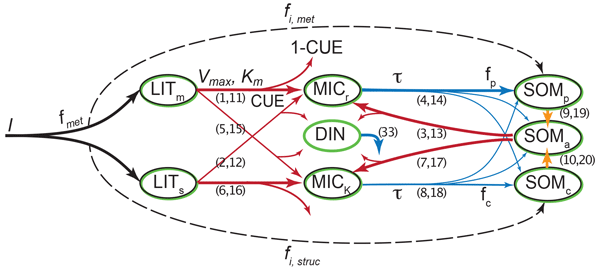Modeling Microbial Traits
Improving biogeochemical models with microbial traits
I am interested in understanding how and when microbial traits can help improve biogeochemical models of carbon cycling.
Linking empirical observations to modelable microbial traits
Many microbial-explicit models characterize microbial decomposers along several trait axes related to their growth rate, stress-tolerance, and abilities to compete for carbon and nutrients. Other microbially-explicit models use a more granular approach and characterize microbes according to functional guilds (for example methanogens, acetogens, and nitrogen fixers). The reality is, of course, more complex, given the enormity of microbial functional and life history diversity. But there is a disconnect between these theoretical conceptualizations of microbes, and our ability to measure and verify these dynamics in empirical studies.
I use a combination of traditional and molecular microbiological techniques to link microbial traits and functional guilds that are portrayed in biogeochemical models to empirical observations from the lab and field.


Understanding the implications of adding microbial traits to models
Explicitly representing microbial traits in models can add complexity to already complex earth-system and ecosystem models, but it can also capture soil carbon and nitrogen biogeochemistry more accurately - allowing us to get the “right answer for the right reason”. In particular, capturing microbial traits may help us better capture soil-atmosphere feedbacks under non-steady state conditions. These non-steady state conditions are increasingly the norm, as the planet rapidly warms.
For example, permafrost soils store approximately one third of the world’s soil C (Hugelius et al. 2014), and projected warming over the century will make this pool vulnerable to decomposition. Complex interactions between plant roots, microbial communities, and soil minerals are expected to create a C feedback to the atmosphere through a process called priming. Priming occurs when plant roots stimulate excess decomposition of previously stored soil C and will likely increase with increased CO2 and warming (Keuper et al. 2020, Hicks Pries et al. 2016). While frequently observed in the field and laboratory (Keuper et al. 2020, Liu et al. 2020, Wild et al. 2023) priming is rarely accounted for in land models which instead suggest that increases in plant productivity will offset soil C loss through 21006 (Koven et al. 2015). Many proposed mechanisms of priming rely on microbial traits that are not well-represented in models. By explicitly or implicity adding the microbial traits involved in priming to microbially explicit models, we can better understand the importance of these traits to carbon cycle feedbacks.

References
- Hugelius, G. et al. Estimated stocks of circumpolar permafrost carbon with quantified uncertainty ranges and identified data gaps. Biogeosciences 11, 6573–6593 (2014).
- Keuper, F. et al. Carbon loss from northern circumpolar permafrost soils amplified by rhizosphere priming. Nature Geoscience 13, 560–565 (2020).
- Hicks Pries, C. E., Schuur, E. A. G., Natali, S. M. & Crummer, K. G. Old soil carbon losses increase with ecosystem respiration in experimentally thawed tundra. Nature Climate Change 6, 214–218 (2016).
- Liu, X. A. et al. The soil priming effect : Consistent across ecosystems , elusive mechanisms. Soil Biology and Biochemistry 140, 107617 (2020).
- Wild, B., Monteux, S., Wendler, B., Hugelius, G. & Keuper, F. Circum-Arctic peat soils resist priming by plant-derived compounds. Soil Biology and Biochemistry 180, 109012 (2023).
- Koven, C. D., Lawrence, D. M. & Riley, W. J. Permafrost carbon−climate feedback is sensitive to deep soil carbon decomposability but not deep soil nitrogen dynamics. Proceedings of the National Academy of Sciences 112, 3752–3757 (2015).